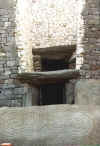|
|

|

Flints Beggarstown,
Co. Antrim |
The
Neolithic Age
c.
4000 - 2000 B.C.
The
First Farmers |

Reconstruction of
Neolithic house |
It seems that there was a gradual changeover from the
Mesolithic era to the Neolithic era, with new settlers arriving in Ireland
bringing new farming techniques. This was the era of more settled peoples
who grew their own crops and laid by stores of grains to tide them over the
winter. They still hunted and gathered in berries and nuts but now their
diet was supplemented on a regular basis by the produce of their crops, and by
the domesticated animals they now kept such as pigs, sheep, cattle and hunting
dogs who kept predators at bay and warned of intruders.
|
This left them more time to create artworks and
decorated utensils. The decorated macehead found at Knowth is one of
the most beautiful pieces of art that has come down to us from Neolithic
times. It would have been used for ceremonial purposes. |

Knowth Macehead |
|

Funerary pottery |
The earliest examples of pottery found in Neolithic times
are plain not over decorated bowls with a 'shoulder' or a 'neck' to
separate the top from the containment area. A variety of colours of
pottery came about due to different clay used and different firing
methods. In the later Neolithic the pottery becomes more
decorative. Most pottery has been found at the excavations of burial
sites, remains were cremated and the burnt bones buried along with the
urns. Some of the later decorated pottery was
probably used as status symbols by the leaders of the communities. In the
earlier examples the pottery is round bottomed and only in the late
Neolithic does it become flat bottomed. |
|
Decorative Jewellery in the form of beads and
pendants were produced by the Neolithic peoples. They were made from
stone, and bone and even the teeth of animals, as in the example from
Annaghmare, Co. Armagh of a bear's tooth pendant. There are no
examples yet of amber or jet beads from this time period. |

Carrowkeel beads and
pendants |
The houses built at this time are much more permanent than
those of Mesolithic times, (picture). The
Neolithic house builders chose the site of their homes very well; they needed to
be close to water, good arable land, land for animals to graze on, with building
materials such as wood nearby also. The remains of the house found at
Lough Gur provided enough evidence for archaeologists to extrapolate what the
whole house would have looked like. Reconstructions of Neolithic houses
can be seen at the Ulster History Park, Omagh, Co. Tyrone and also at Lough Gur,
Co. Limerick.
|

Entrance to Newgrange
Monument |
Many writers claim that it was the Neolithic people
that built the Megalithic structures such as those at Newgrange, Knowth
and Poulnabrone simply because burial remains were found at these sites
which were carbon dated to Neolithic times. By that same logic if I
was buried in a 17th century house and my remains were discovered
thousands of years later, it would be assumed that the people of my time
had built the house or structure I was buried under, ... so there is a very big flaw in the arguments of the
archaeologists who claim that a people who are still in the 'Stone Age'
could have constructed some of the Megalithic structures which have
complex alignments to solar events as well as to lunar events which would
have to be observed and known about for thousands of years.. |
Therefore we at shee-eire have an open mind on who might
have constructed the Megalithic
monuments, we do not believe that these
monuments were all constructed in Neolithic times, many could have been
constructed thousands of years before Neolithic times by a people with advanced
knowledge of astronomy and engineering.
Sources: Irish
Archaeology Illustrated edited by Michael Ryan pub. Dublin 1994
Harbison, Peter - Pre-christian Ireland,
from the first settlers to the Early Celts, pub. Thames&Hudson 1998.
top
Last Updated -
August 3, 2023

© Shee-Eire:
|